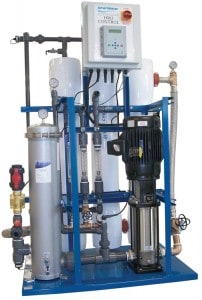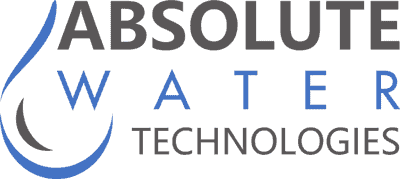Reverse Osmosis Systems (R.O.)- The In’s and Out’s
Understanding Reverse Osmosis (RO) Systems
Principles of Reverse Osmosis
Reverse Osmosis (R.O.) simply stated is the process of Osmosis in reverse. Whereas Osmosis occurs naturally without energy required, to reverse the process of osmosis you need to apply energy to the more saline solution. A reverse osmosis membrane is a semi-permeable membrane that allows the passage of water molecules but not the majority of dissolved salts, organics, bacteria and pyrogens. To have this process occur you must ‘push’ the water through the reverse osmosis membrane by applying pressure that is greater than the naturally occurring osmotic pressure in order to desalinate (demineralize or deionize) water in the process, allowing pure water through while holding back a majority of contaminants.
Understanding SDI- Silt Density Index
The silt density index is a measure for the fouling capacity of water in reverse osmosis systems. The test measures the rate at which a 0.45-micrometre filter is plugged when subjected to a constant water pressure of 206.8 kPa (30 psi).[1] The SDI gives the percent drop per minute in the flow rate of the water through the filter, averaged over a period of time such as 15 minutes.
Typically, spiral wound reverse osmosis systems will need an SDI less than 5, and hollow fiber reverse osmosis systems will need an SDI less than 3. In these kinds of systems, deep well waters (with a typical SDI of 3) could be used straight from the source. If fed from surface waters (with a typical SDI greater than 6), the water will need to be filtered before use
R.O. System Components
The selection of process components of RO-Nano filtration system is affected to the great extent by the type of water the membrane plant will process.
-Feed water source- Wells or City Water
– Screening/ Use Of a multi-media Filter- This, may be necessary especially in well water situations to help remove large particles
– Chemical conditioning (acid and/or scale inhibitor) – Using anti-scalant is very popular and removes the necessity of a water softener in the system
– Cartridge filtration Pre-treatment is key to a reverse osmosis system, removal of hard water and chlorine before entering the system can be very cost-effective and save the membranes. Hard water can foul out the membrane surfaces and leave them ineffective, organics can create an impenetrable barrier and chlorine can eat holes through the membranes. Typically a 5 micron filter is right before the entry of the RO unit.
– High pressure pumps- Since reverse osmosis relies on applying pressure it is imperative that the correct pump is selected. An under-performing pump can greatly impact the effectiveness of your system.
Membranes- This is the most critical part of an RO system and is worthy of it’s own blog topic to come out soon. When selecting or replacing membranes for a current Reverse Osmosis (RO) unit pay attention to ratings and rejection capability. Low versus high pressure potentials in the membranes are important as well.
– RO trains The way the tubing is configured in your system is key. Systems can be double or single pass and can use part of the concentrate water to be refed (recycled) back through the reverse osmosis system to help with overall energy use and recovery.
– Membrane cleaning unit.- Cleaning RO membranes is essential to best possible performance and longevity of the membranes always follow OEM membrane (Filmtec, Toray etc) recommendations on cleaning . All membranes are not meant to be cleaned in the same fashion. Some RO’s come with a C.I.P. (Clean in place) unit for ease of cleaning. Many companies such as Absolute Water Technologies have varying sizes of portable skids that can be brought on site. Some systems also incorporate a heater in the skid to increase cleaning effectiveness with a warmer solution.
Single Pass versus Double Pass- Reverse Osmosis (RO) System
Think of a pass as a stand -alone RO Reverse Osmosis system. With this in mind, the difference between a single pass RO system and a double pass RO system is that with a double pass RO, the permeate from the first pass becomes the feed water to the second pass (or second RO) which ends up producing a much higher quality permeate because it has essentially gone through two RO systems.
Besides producing a much higher quality permeate, a double pass system also allows the opportunity to remove carbon dioxide gas from the permeate by in some models injecting caustic between the first and second pass. C02 is undesirable when you have mixed bed ion exchange resin beds after the RO. By adding caustic after the first pass, you increase the pH of the first pass permeate water and convert C02 to bicarbonate (HCO3-) and carbonate (CO3-2) for better rejection by the RO membranes in the second pass. This can’t be done with a single pass RO because injecting caustic and forming carbonate (CO3-2) in the presence of cations such as calcium will cause scaling of the RO membranes.
There are many double pass system however that do not inject caustic on the second pass but still carry the benefit of a higher water quality. This can be essential in applications where being polished by deionization (SDI/DI) or portable service deionization tanks is too aggressive. A double pass system can get you to the bottom scale of conductivity without tipping you into the scale of resistivity.
Effects from Water Temperature
In general the colder the water the thicker the water becomes which translates into two outcomes, less permeate production of water overall from an Reverse Osmosis Membrane but also a better rejection rate of dissolved solids. The warmer the water temperature, the higher the production rate or efficiency but a lower rate of effectiveness allowing more of the concentrate contaminants to slip through. Below is a general calculation and examples to determine the efficiency of an RO membrane as effected by temperature. Many membranes will have an upper temperature limit around 100 degrees Fahrenheit. At higher temperatures membranes can become damaged. Lower temperatures can create a high pressure problem in some systems. In many cases, a blending valve is worth the money to ensure reliable RO performance.
Celcius 25 / Fahrenheit 77= Multiplier of 1.00
Celcius 10 / Fahrenheit 50= Multiplier of .63
Celcius 38 / Fahrenheit 98.6= Multiplier of 1.40
Recovery Percentage
The maximum percent recovery possible in any RO system usually depends not on a limiting osmotic pressure, but on the concentration of salts present in the feed-water and their tendency to precipitate on the membrane surface as mineral scale. The most common sparingly soluble salts are calcium carbonate (limestone), calcium sulfate (gypsum), and silica. Chemical treatment of feed-water can be used to inhibit mineral scaling.
% Recovery = (Product flow rate ÷ Feed flow rate) × 100
High Recovery RO- Reverse Osmosis System
A high recovery RO allows users to recover 50% of the concentrate that would otherwise go to waste. This increases overall RO system recovery by 10 – 15%, bringing total recovery to 85 – 90%. Surprisingly some processes allow users to boost their water system recovery without increasing the energy consumed in the conversion. The process can often be retrofitted onto existing RO systems. See Absolute Water Technologies in regard to looking at retrofitting your current system.
RO Membrane normalization is important in determining time to clean or replace RO membranes and this involves tracking:
- Feed Temp (F°)
- Permeate Flow (GPM)
- Concentrate Flow (GPM)
- Feed Pressure (PSI)
- Concentrate Pressure (PSI)
- Permeate Pressure (PSI)
- Feed Conductivity
- Permeate Conductivity
When looking at RO performance, trending will let you know when it is time to address the membrane effectiveness. Having a service company just track numbers is half of the trick. Knowing how to read and address the statistics will help improve the effectiveness and efficiency of your system. For Preventative maintenance service in the Midwest (Indiana, Missouri, Illinois, Ohio, Kentucky and beyond) contact us today. We also provide equipment leasing, sales and general service on all reverse osmosis equipment including membrane replacement, off-site and on-site cleanings and troubleshooting.
Contact us at Absolute Water Technologies for free technical support in sizing and designing your reverse osmosis system or for any other free technical advice in the area of High Purity Water Treatment. To learn more, see us at www.absolutewatertech.com or call us at 1-866-986-6860

